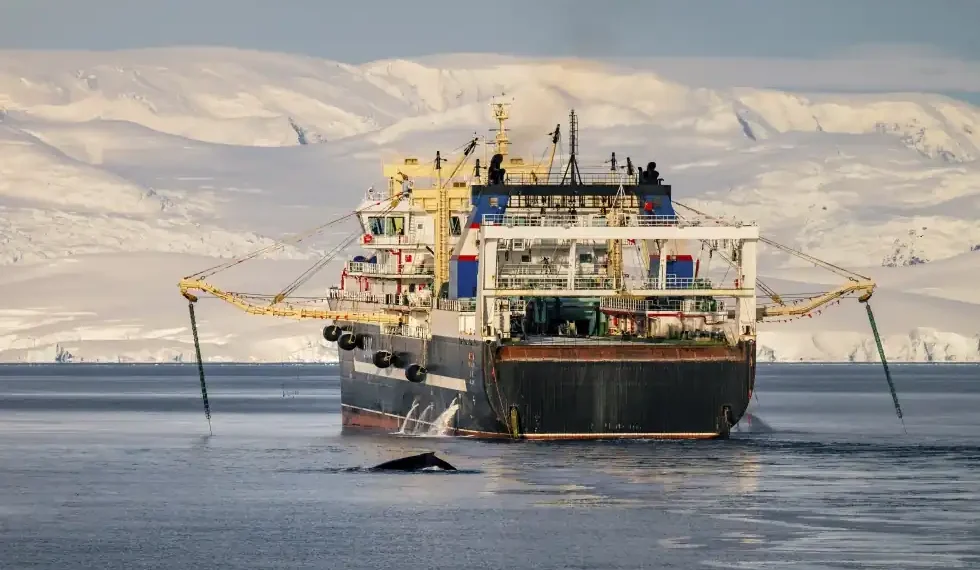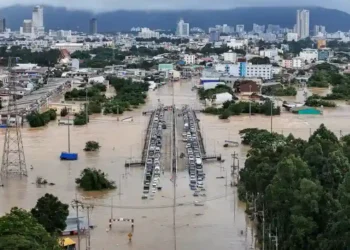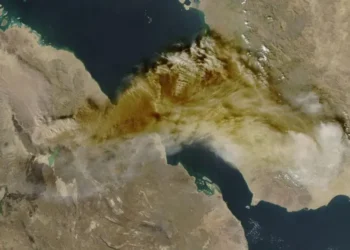Record krill catch in Antarctica triggers concern over fishery closure, whale safety, and climate impact
Written: July 29, 2025, 18:00 EDT
Industrial fishing for krill in the Southern Ocean has reached record-breaking levels, raising serious concerns among scientists, conservation groups, and international regulators. With 84% of the seasonal catch quota already reached by mid-year, officials warn that the fishery may be forced to close early — a first in its history.
Environmental experts say the rapid increase in krill harvesting near the Antarctic Peninsula could jeopardize the health of the marine ecosystem, undermine climate regulation, and intensify conflict between commercial interests and wildlife conservation.
Krill catch nears critical threshold
According to data reviewed by the Commission for the Conservation of Antarctic Marine Living Resources (CCAMLR), krill fishing in the 2024–2025 season has already reached 518,568 metric tons, or about 84% of the annual 620,000-ton limit. That threshold, if exceeded, would trigger an automatic closure of the fishery.
The report, not officially released to the public, was obtained by the Associated Press from a source concerned about overfishing. The individual, who requested anonymity, said krill are being increasingly caught in concentrated areas, putting added pressure on wildlife such as whales, seals, and penguins that rely on the tiny crustaceans for food.
“Most of the krill is being taken from smaller and smaller hotspots,” said Capt. Peter Hammarstedt, campaign director for Sea Shepherd Global, which recently completed its third monitoring voyage in the region. “It’s like saying you’re only taking 1% of deer in the U.S., but you’re hunting all of them in Rhode Island.”
Why krill matters: ecosystem and climate
Krill may be tiny — comparable in size to a paper clip — but their role in marine ecosystems is massive. With a global biomass estimated at 63 million metric tons, krill serve as the primary food source for numerous species, including whales, seals, penguins, and fish.
They’re also vital to the planet’s fight against climate change. According to a peer-reviewed study published last year, krill contribute to the removal of 20 million tons of carbon from the atmosphere annually by sequestering it in the ocean — roughly equal to the emissions of 5 million cars.
But that role is under growing threat. Climate change, advances in trawling technology, and a booming market for krill-based products — including omega-3 supplements, fishmeal, and pet food — have sharply increased demand.
During the 2023–24 season, a fleet of 12 industrial trawlers, mostly from Norway and China, harvested 498,350 tons of krill — until now the largest catch on record since CCAMLR began tracking such data in 1973.
Whale injuries, dead zones, and ecological stress
The impacts of krill fishing are not abstract. During recent seasons, observers documented humpback whales becoming entangled or injured in the massive cylindrical nets used to harvest krill.
AP journalists who traveled to the Southern Ocean in 2023 reported vessels trawling in close proximity to whale feeding grounds. The concern is compounded by the fact that many whale populations, still recovering from industrial whaling, rely heavily on krill to survive.
Additionally, with expired geographic catch restrictions, trawlers now have access to critical marine habitats without the previous spatial limits that distributed fishing more evenly. These expired controls had been in place for 15 years but were not renewed due to political gridlock at last year’s CCAMLR meeting.
Failed management deal triggers regulatory breakdown
Efforts to adopt a new krill management plan collapsed at the 2024 CCAMLR summit, where Russia, China, the United States, and over two dozen other countries failed to reach consensus.
The proposed plan included the creation of a California-sized marine reserve around the Antarctic Peninsula — the continent’s most biologically rich and visited region. It also aimed to spread out catch zones to reduce concentrated fishing pressure.
However, negotiations unraveled after the United Kingdom and Australia submitted a last-minute proposal to lower catch limits further. That move reportedly led China to withdraw support, effectively blocking the plan and allowing prior restrictions to expire.
“The truth was it was the UK,” said Matts Johansen, CEO of Aker BioMarine, the largest krill-based product supplier, during a speech at the UN Oceans Conference in June 2025. “Just a couple days before the vote, the UK threw another suggestion and that’s when the Chinese backed off.”
The UK Foreign Office denied the allegation, stating it continues to support sustainable krill fishing and robust marine protection measures.
Industry defends current catch as sustainable
In response to rising concern, Javier Arata, executive director of the Association of Responsible Krill Harvesting Companies, which accounts for 95% of krill harvests, said the higher catch levels are still sustainable and based on prior scientific consensus.
He noted that the expired catch-spreading measures were intended to be temporary and that ongoing political disagreements — not scientific recommendations — are to blame for the current regulatory gap.
Arata also emphasized that his organization supports the creation of marine protected areas in Antarctica but urged regulators not to delay adoption of scientifically “ready-to-go” reforms while awaiting political consensus.
Satellite data confirms concentrated trawling
Global Fishing Watch, a U.S.-based nonprofit that monitors fishing activity through satellite data, confirmed that trawling has intensified in known krill hotspots.
In particular, fishing activity in Sub-Area 48.1, a region near the Antarctic Peninsula, has more than doubled this season compared to all of last year. The group, which collaborates with international bodies to promote transparency, said the increased clustering of vessels adds stress to already vulnerable ecosystems.
What’s next for Antarctic krill management?
With the krill season nearing its automatic shutdown point and no new management plan in place, pressure is mounting on CCAMLR to act quickly before long-term ecological damage is done.
Currently, less than 5% of the Southern Ocean is protected, far short of the 30% conservation target set by the United Nations for global oceans by 2030. Without renewed restrictions or marine reserve designations, environmental groups fear the krill fishery could become unsustainable, undermining decades of marine conservation work.
For now, as vessels continue to harvest krill at unprecedented rates, the future of Antarctica’s most critical — and often overlooked — species remains uncertain.
This article was rewritten by JournosNews.com based on verified reporting from trusted sources. The content has been independently reviewed, fact-checked, and edited for accuracy, neutrality, tone, and global readability in accordance with Google News and AdSense standards.
All opinions, quotes, or statements from contributors, experts, or sourced organizations do not necessarily reflect the views of JournosNews.com. JournosNews.com maintains full editorial independence from any external funders, sponsors, or organizations.
Stay informed with JournosNews.com — your trusted source for verified global reporting and in-depth analysis. Follow us on Google News, BlueSky, and X for real-time updates.














